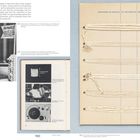Otti Berger. Weaving for Modernist Architecture, Gebunden
Otti Berger. Weaving for Modernist Architecture
- Englische Ausgabe mit deutschsprachigem Begleitheft
- Herausgeber:
- Judith Raum, Bauhaus-Archiv Berlin Museum für Gestaltung
- Fotos:
- Uta Neumann
- Verlag:
- Hatje Cantz Verlag GmbH, 03/2024
- Einband:
- Gebunden
- Sprache:
- Deutsch, Englisch
- ISBN-13:
- 9783775756419
- Artikelnummer:
- 11563955
- Umfang:
- 352 Seiten
- Sonstiges:
- 500 Fotos
- Gewicht:
- 1982 g
- Maße:
- 317 x 228 mm
- Stärke:
- 35 mm
- Erscheinungstermin:
- 25.3.2024
Weitere Ausgaben von Otti Berger. Weaving for Modernist Architecture |
Preis |
|---|
Klappentext
Otti Berger created fabrics that fundamentally changed the understanding of what textiles could be and do. A core member of the experimental approach to textiles at the Bauhaus, she was also a female entrepreneur in the frenzied time that was the early 1930s in Berlin. Working closely with architects of the New Objectivity movement such as Lilly Reich, Ludwig Hilberseimer and Hans Scharoun, she designed upholstery and wall tapestries, curtains and floor coverings that responded to novel types of use and production methods, and thereby redefined the relationship between aesthetics and function¿with fascinating results. To date Berger's textile work has only been explored in fragments. This book is the first comprehensive study of its complexity and beauty and makes her hitherto unpublished treatise on fabrics and the methodology of textile production accessible. Raum's research offers an entirely new perspective on Berger's oeuvre.
OTTI BERGER (1898-1944) was one of the most important textile
designers of the 20th century. Born in Zmajevac, in the Austro- Hungarian Empire, present-day Croatia, she studied in Zagreb
and from 1927 at the Bauhaus in Dessau. Leaving her teaching post at the Bauhaus, she set up her own business in Berlin in 1932 to design fabrics for modern interiors, but was banned from working due to her Jewish heritage in 1936. Attempts to escape to England and the USA failed. She was deported from Croatia to Auschwitz and was murdered there in 1944.
In cooperation with the Bauhaus Archive Berlin, visual artist and art historian JUDITH RAUM (*1977) has conducted intensive research in European and North American archives to complete the first comprehensive study of Berger's scattered estate.
Anmerkungen:
Bitte beachten Sie, dass auch wir der Preisbindung unterliegen und kurzfristige Preiserhöhungen oder -senkungen an Sie weitergeben müssen.
























